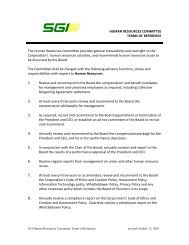Full report - SGI Canada
Full report - SGI Canada
Full report - SGI Canada
Create successful ePaper yourself
Turn your PDF publications into a flip-book with our unique Google optimized e-Paper software.
<strong>SGI</strong> CANADA’s brokers are well-known in the communities in which they operate and they actively<br />
promote the Corporation’s products and services. To support its brokers, the Corporation is continually<br />
enhancing broker web interfaces to make it easier for them to promote its products and to provide them<br />
with the self-service capabilities they have requested. Through 2010, the Corporation will continue to<br />
implement and monitor its comprehensive eServices strategy to ensure projects are implemented on time,<br />
on budget and that they deliver specified benefits. The Corporation provides other services to ensure a<br />
strong commitment between brokers and <strong>SGI</strong> CANADA. This business model has brought the Corporation<br />
success in seven different markets in <strong>Canada</strong>, and it will continue to market its products this way, building<br />
its broker relationships into the future.<br />
Technology<br />
<strong>SGI</strong> CANADA relies on technology and systems to maintain its in-house underwriting system. Its general<br />
insurance system is flexible and can adapt to the changing competitive environment that <strong>SGI</strong> CANADA<br />
operates in. The Corporation has developed a large database of information in this system that provides<br />
valuable information in assessing insurable risks. Management <strong>report</strong>ing systems are utilized to ensure<br />
management receives timely information regarding operations and to provide complete and accurate<br />
<strong>report</strong>ing to stakeholders and regulators. The Corporation monitors and responds to changes in<br />
technology to ensure that key areas are upgraded in a timely manner.<br />
In 2009, a business intelligence project was approved to further leverage the data in the Corporation’s<br />
general insurance system in order to produce timely, sophisticated and consistent information for the<br />
decision-making support required to succeed in a competitive environment. This is an important project<br />
for the Corporation and will expand its ability to:<br />
○○<br />
Focus on key performance indicators, ensuring alignment with corporate objectives and strategies, and<br />
a quicker response to changes in the business environment.<br />
○○<br />
Focus on obtaining more profitable business and more accurately pricing risks.<br />
○○<br />
Better manage and control claim costs.<br />
○○<br />
Have consolidated views of customers, brokers and issuers.<br />
○○<br />
Reduce the risk associated with using incomplete, inconsistent or inaccurate information.<br />
○○<br />
Allow easier access to information in a self-service <strong>report</strong>ing environment.<br />
Work on this initiative began in early 2010, with implementation of aspects of this system expected to<br />
begin in 2011.<br />
Financial capital<br />
Adequate capitalization is crucial for insurers competing in the P&C insurance market in <strong>Canada</strong>. Not only<br />
is it important to ensure adequate funding is available to pay policyholder claims, but it allows a company<br />
to be flexible in its product offering mix in a competitive marketplace. In addition, regulators have certain<br />
capital requirements that must be met in order to sell P&C insurance in each province. Without adequate<br />
capitalization, <strong>SGI</strong> CANADA would not be capable of meeting its growth targets.<br />
The Corporation’s main sources of capital are retained earnings and cash injections in the form of equity<br />
advances from its parent, CIC. These equity advances form the Corporation’s equity capitalization. There<br />
were no new equity advances to <strong>SGI</strong> from its parent in 2010 and there were no changes to the capital of the<br />
Corporation’s subsidiaries during the same time period.<br />
In <strong>Canada</strong>, either the Office of the Superintendent of Financial Institutions or provincial regulators regulate<br />
P&C insurers. Regulators require insurers to maintain a level of capital sufficient to achieve a minimum<br />
capital test target of 150%. <strong>SGI</strong> CANADA uses this test to assess its capital adequacy, as discussed in the<br />
Corporate Strategies section of this <strong>report</strong>. Management of the Corporation believes <strong>SGI</strong> CANADA and<br />
each of its subsidiaries is adequately capitalized to meet capital targets, as well as to achieve targets for<br />
premium growth for the next five years.<br />
Financial liquidity represents the ability of <strong>SGI</strong> CANADA’s companies to fund future operations, pay claims<br />
in a timely manner and grow. A main indicator of liquidity is the cash flow generated from operating<br />
activities. This is a Canadian generally accepted accounting principle (GAAP) measurement and is<br />
<strong>report</strong>ed on the Consolidated Statement of Cash Flows. For 2010, <strong>SGI</strong> CANADA generated consolidated<br />
operating cash flows of $52.7 million. This cash flow is invested so that it is available to pay claims as they<br />
come due and also to meet its dividend requirements to its parent, CIC.<br />
For the cash flow the Corporation retains, its enabling legislation requires it to follow the same investment<br />
criterion that federally regulated P&C companies must follow. This means the majority of the Corporation’s<br />
investments are in highly liquid securities that can be sold in a timely manner in order to satisfy financial<br />
commitments. As at December 31, 2010, 45% (2009 – 44%) of the investment portfolio was in treasury<br />
bills and highly liquid bonds and debentures issued by the federal and provincial governments. The<br />
Corporation also invests in corporate bonds, a pooled mortgage fund, publicly traded North American<br />
equities and a non-North American pooled equity fund.<br />
During the current year, dividends of $43.5 million (2009 – $34.0 million) were declared, which represents<br />
a dividend rate of 90% of consolidated net income (2009 – 65%). At the same time, adequate capital has<br />
been maintained within the Corporation to meet its capital targets and its financial obligations as they<br />
come due.<br />
2010 Financial Results<br />
For the year ended December 31, 2010<br />
Overview of operations<br />
<strong>SGI</strong> CANADA’s consolidated net income before income taxes and non-controlling interest was<br />
$51.3 million in 2010, $2.0 million lower than 2009. However, the 2010 profit is significant when considering<br />
the exceptional storm activity experienced during the year and that the 2009 result was a record profit<br />
for the Corporation. The 2010 return resulted from a consolidated underwriting profit of $13.1 million<br />
combined with $38.3 million in investment earnings. The breakdown by operating segment follows:<br />
Pre-tax profit (loss) by operating segment<br />
2010<br />
% of pre-tax<br />
profit<br />
(thousands of $)<br />
2009<br />
% of pre-tax<br />
profit (loss)<br />
<strong>SGI</strong> CANADA - Saskatchewan $ 43,284 84.3% $ 49,539 92.8%<br />
<strong>SGI</strong> CANADA - Manitoba and Alberta 4,130 8.1% 4,404 8.2%<br />
ICPEI (Maritimes) 2,739 5.3% 205 0.4%<br />
Coachman (Ontario) 1,192 2.3% (761) (1.4%)<br />
Pre-tax profit $ 51,345 100.0% $ 53,387 100.0%<br />
32 | 2010 MANAGEMENT’S DISCUSSION AND ANALYSIS MANAGEMENT’S DISCUSSION AND ANALYSIS 2010 | 33















